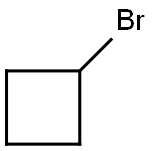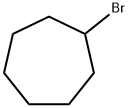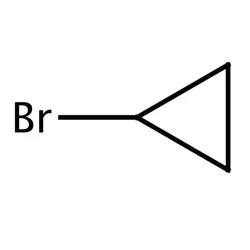Cyclopropyl bromide
Synonym(s):Cyclopropyl bromide
- CAS NO.:4333-56-6
- Empirical Formula: C3H5Br
- Molecular Weight: 120.98
- MDL number: MFCD00001271
- EINECS: 224-375-7
- SAFETY DATA SHEET (SDS)
- Update Date: 2025-09-25 17:15:13

What is Cyclopropyl bromide?
Description
Cyclopropyl bromide is also named as Bromocyclopropane. It is used in organic synthesis, for instance, for the formation of a Grignard Reagent, cyclopropyllithium. It is also used as an intermediate in the manufacture of pharmaceutical and agrochemical products.
Chemical properties
Light yellow to clear colourless liquid, boiling point 67-69°C, refractive index (nD20) 1.4605, density (d420) 1.5120, flash point -6°C.
The Uses of Cyclopropyl bromide
Bromocyclopropane is primarily used an intermediate in the manufacture of pharmaceutical and agrochemical products. It is also used in the production of cyclopropyl boric acid. It is used as an intermediate in organic synethesis.
Preparation
Bromocyclopropane has been prepared by the Hunsdiecker reaction by adding silver cyclopropanecarboxylate to bromine in dichlorodifluoromethane at ?29° (53% yield) or in tetrachloroethane at ?20° to ?25° (15–20% yield). Decomposition of the peroxide of cyclopropanecarboxylic acid in the presence of carbon tetrabromide gave bromocyclopropane in 43% yield. An attempt to prepare the bromide via the von Braun reaction was unsuccessful. Ten percent yields are reported for the photobromination of cyclopropane and the photochemical rearrangement of allyl bromide. Treatment of 1,1,3-tribromopropane with methyllithium prepared from methyl bromide furnishes a 60–65% yield of bromocyclopropane.
What are the applications of Application
Bromocyclopropane have anti-angiogenic effects that inhibits the growth of new blood vessels by interfering with the production of prostaglandins and nitric oxide, which are important for the formation of new blood vessels. Bromocyclopropane binds to cyclopropyl and hydrochloric acid, forming a hydrogen bond. It also forms a hydrogen bond with fatty acids and an a-type hydroxyl group.
References
Science of Synthesis: Houben-Weyl Methods of Molecular Transformation Vol. 7: Compounds of Group 13 and 2 (Al, Ga, In, Tl, Be…Ba), 2007, ISBN: 9783131484819
D. Seyferth, H. M. Cohen, The Stability of Cyclopropyllithium in diethyl ether and in tetrahydrofuran, Journal of Organometallic Chemistry, 1963, vol. 1, pp. 15-21
“Formal Nucleophilic Substitution of Bromocyclopropanes with Azoles”, Ryabchuk, P.; Rubina, M.; Xu, J.; Rubin, M. Org. Lett. 2012, 14, 1752.
“Formal Substitution of Bromocyclopropanes with Nitrogen Nucleophiles”, Banning, J. E.; Gentillon, J.; Ryabchuk, P. G.; Prosser, A. R.; Rogers, A.; Edwards, A.; Holtzen, A.; Babkov, I.; Rubina, M.; Rubin, M. J. Org. Chem., 2013, 78, 7601.
Properties of Cyclopropyl bromide
| Boiling point: | 69 °C (lit.) |
| Density | 1.51 g/mL at 25 °C (lit.) |
| refractive index | n |
| Flash point: | 20 °F |
| storage temp. | 2-8°C |
| solubility | Chloroform (Sparingly), Methanol (Slightly) |
| form | Liquid |
| color | Clear colorless |
| Specific Gravity | 1.510 |
| Water Solubility | immiscible |
| BRN | 1900287 |
| CAS DataBase Reference | 4333-56-6(CAS DataBase Reference) |
| NIST Chemistry Reference | Cyclopropyl bromide(4333-56-6) |
| EPA Substance Registry System | Cyclopropane, bromo- (4333-56-6) |
Safety information for Cyclopropyl bromide
| Signal word | Danger |
| Pictogram(s) |
 Flame Flammables GHS02 |
| GHS Hazard Statements |
H225:Flammable liquids |
| Precautionary Statement Codes |
P210:Keep away from heat/sparks/open flames/hot surfaces. — No smoking. P233:Keep container tightly closed. P240:Ground/bond container and receiving equipment. P241:Use explosion-proof electrical/ventilating/lighting/…/equipment. P242:Use only non-sparking tools. P243:Take precautionary measures against static discharge. |
Computed Descriptors for Cyclopropyl bromide
Cyclopropyl bromide manufacturer
JSK Chemicals
Sainor Laboratories Pvt Ltd Unit III
New Products
4,4-Difluoropiperidine hydrochloride tert-butyl 9-methoxy-3-azaspiro[5.5]undecane-3-carboxylate Indole Methyl Resin N-Isopropylurea N,N-Dicyclohexylcarbodiimide(DCC) MELDRUMS ACID 5-METHYLISOXAZOLE-4-CARBOXYLIC ACID Magnessium Bis glycinate Zinc ascorbate 1-bromo-2-butyne 2-acetamidophenol 9(10H)-anthracenone Erythrosin B, 4-Piperidinopiperidine 2-((4-morpholinophenylamino) (methylthio) methylene) malononitrile 2,4-dihydroxybenzaldehyde 3-(4-morpholinophenylamino)-5-amino-1H-pyrazole-4-carbonitrile Methyl 2-methylquinoline-6-carboxylate 2,6-dichloro-4-nitropyridine 4-Bromo-2-chlorobenzonitrile 2-(benzylamino)acetic acid hydrochloride 4-(tert-Butoxycarbonylamino)but- 2-ynoic acid 3,4-dihydro-2H-benzo[b][1,4]dioxepine 1-Phenyl-1-cycloprppanecarboxylicacidRelated products of tetrahydrofuran








You may like
-
 Cyclopropyl Bromide / Bromo cyclopropane 4333-56-6 99%View Details
Cyclopropyl Bromide / Bromo cyclopropane 4333-56-6 99%View Details
4333-56-6 -
 4333-56-6 98%View Details
4333-56-6 98%View Details
4333-56-6 -
 Bromocyclopropane, 98% 4333-56-6 99%View Details
Bromocyclopropane, 98% 4333-56-6 99%View Details
4333-56-6 -
 Bromocyclopropane CAS 4333-56-6View Details
Bromocyclopropane CAS 4333-56-6View Details
4333-56-6 -
 Bromocyclopropane CAS 4333-56-6View Details
Bromocyclopropane CAS 4333-56-6View Details
4333-56-6 -
 Bromocyclopropane CAS 4333-56-6View Details
Bromocyclopropane CAS 4333-56-6View Details
4333-56-6 -
 Cyclopropyl Bromide, For Industrial, Grade Standard: Technical GradeView Details
Cyclopropyl Bromide, For Industrial, Grade Standard: Technical GradeView Details
4333-56-6 -
 Cyclopropyl Bromide 4333 56 6View Details
Cyclopropyl Bromide 4333 56 6View Details
4333-56-6
